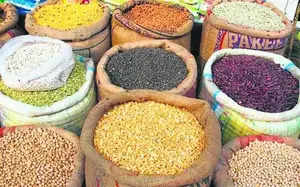India's Aggressive Plan to Conquer Pulse Production: A Boon for Farmers?
Is India on the verge of a pulse revolution? The government certainly seems to think so. With a bold new strategy, they are aiming to not just meet domestic demand but also achieve self-sufficiency in pulses – urad, tur, and masoor. Forget just meeting the demand; this plan aims to unleash a massive surge in production, ensuring fair prices for farmers and stable supplies for consumers. Will this daring scheme actually work, or is it just another ambitious plan destined to fail? Read on to find out!
The Government's Master Plan: A Three-Pronged Approach
The Indian government's approach is aggressive, multi-faceted, and promises a guaranteed lifeline to farmers. This comprehensive strategy focuses on price support, procurement enhancements, and dynamic price adjustments, working simultaneously to impact both the short-term and long-term pulse production in India. The core of the strategy relies on active participation from government agencies like NAFED and NCCF.
Firstly, these two agencies have aggressively pre-registered a whopping 21 lakh farmers. This pre-registration secures procurement of pulses before the sowing season, removing uncertainty and enabling the farmers to plan ahead, potentially stimulating higher production. It helps the farmers gain certainty, ensuring that they are not subjected to distress sales and unfair market conditions.
Secondly, the use of price support schemes (PSS) and price stabilization funds (PSF) aims at ensuring farmers receive fair prices for their produce and keeping the pulses’ market prices from becoming volatile. These funding sources act as safeguards against unexpected price fluctuations.
Finally, this initiative brings to light the "dynamic minimum assured procurement price" (MAPP) method. This forward-thinking approach leverages the dynamic nature of markets and ensures that prices don’t remain fixed even with seasonal variations in supply and demand.
Impact on Farmers: Stability and Encouragement
The core of the initiative is centered on enhancing farmer income, driving sustainable agriculture, and transforming the pulses sector. Through the proposed changes, several benefits could be reaped by the farming community:
- Assured Procurement: The initiative eliminates the uncertainty about buyers, safeguarding against unfair pricing and guaranteeing prompt payment, enabling them to secure loans and investments.
- Fair Pricing: By linking purchase rates to market rates (with a focus on the most recent ones), the initiative gives the pulses’ industry some level of price stability and improves upon minimum support prices (MSP).
- Production Boost: The stability of price and income empowers farmers to plan effectively and boost overall production of pulses, especially for crucial varieties.
Is India Ready for Pulse Self-Sufficiency?
Despite all this positive change, there remain several challenges for this ambitious initiative:
- Storage and Logistics: Scaling up the procurement and storage needs to match the expected increase in production is crucial, preventing losses and spoilage that reduce the benefits for everyone involved.
- Maintaining Fair Prices: Ensuring the sustainability of MAPP and striking a balance between supporting farmers and managing inflation needs a constant check on the system. This careful balancing act has the potential to upset the entire plan.
- Import Policy: A tightrope walk between encouraging domestic production and balancing global trade dynamics is essential. Managing domestic output and global price fluctuations will require finesse.
Tackling Challenges for a Self-Reliant India
Addressing these challenges is crucial for self-sufficiency in pulses production and boosting farmer income. This involves improvements across the board, in several different directions:
- Strengthening Supply Chains: Investment in robust cold storage infrastructure and efficient transportation networks would ensure the safe storage and swift delivery of pulses across the country.
- Dynamic Price Monitoring: Setting up a technologically advanced market information system would help track mandi prices and refine procurement strategies.
- Collaboration and Cooperation: Cooperation with stakeholders, including farmers' organizations and processors, will help build stronger coordination and better management of challenges.
Take Away Points
India's plan to transform its pulse production is bold and ambitious, with the potential to reshape the country’s agricultural landscape. This plan’s success depends on successfully tackling logistical hurdles, implementing advanced market information, and fostering robust collaboration among stakeholders. While there are challenges ahead, the proactive approach taken to directly support and empower farmers offers significant potential for a more prosperous and self-reliant India.









